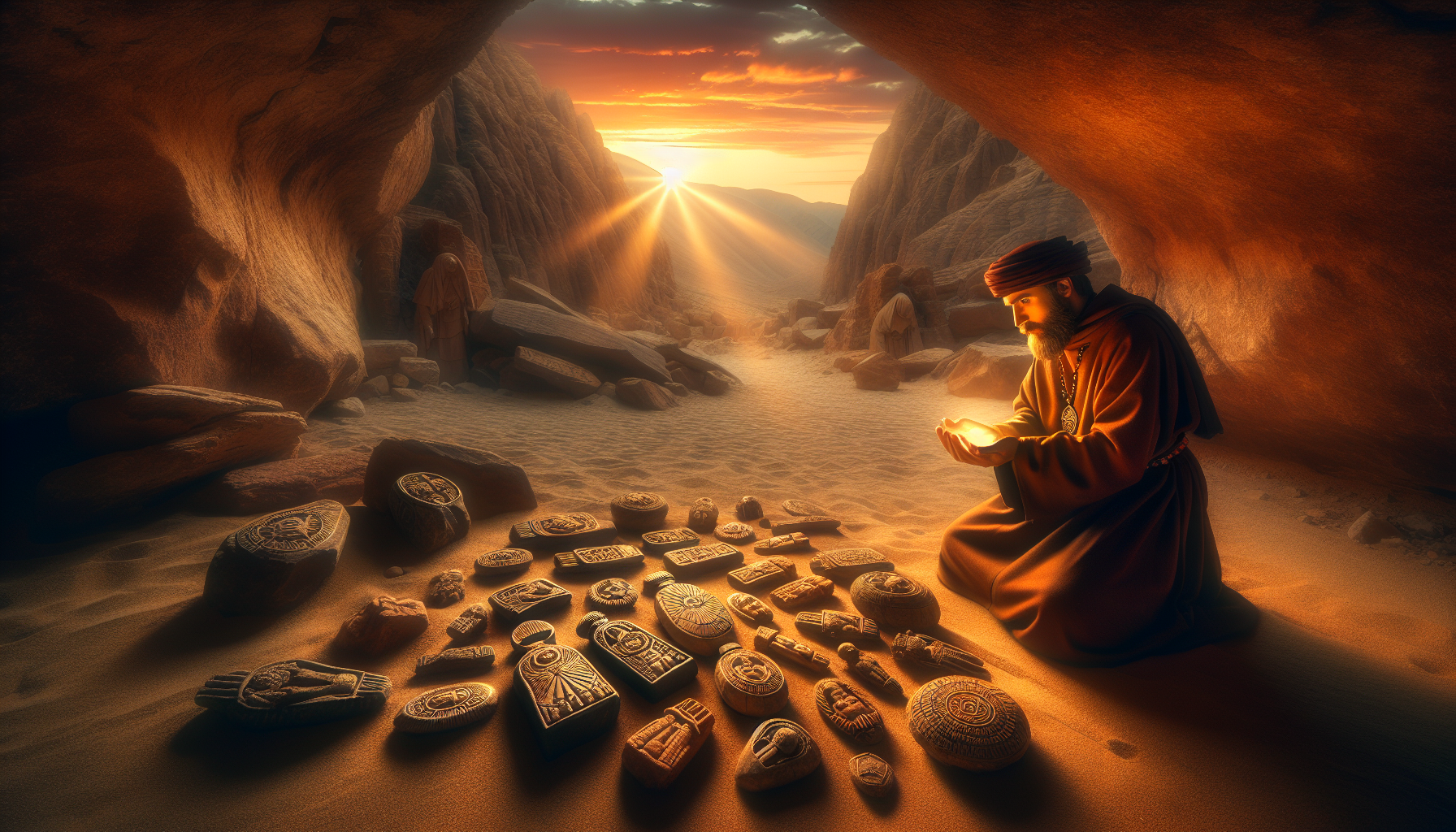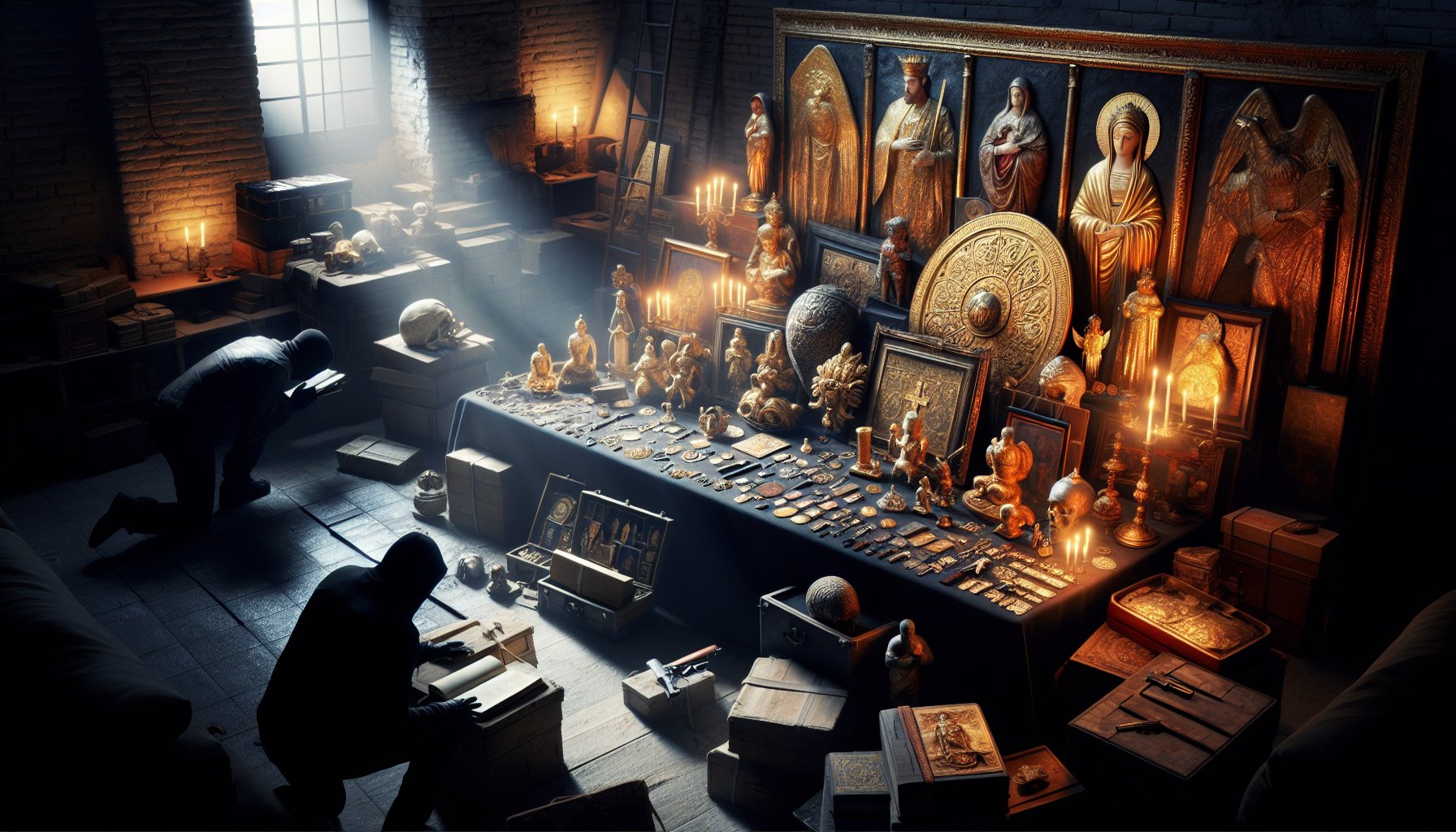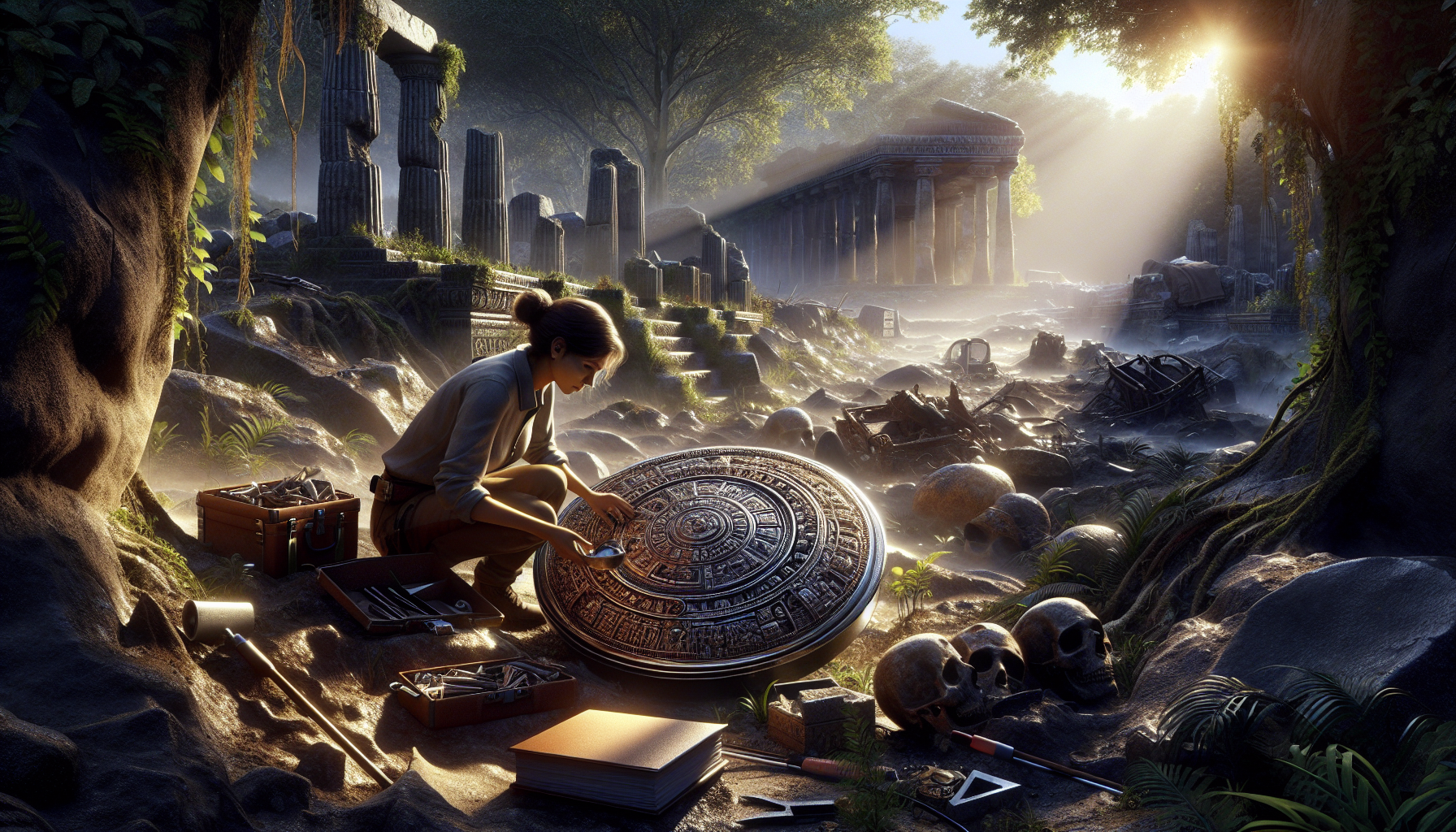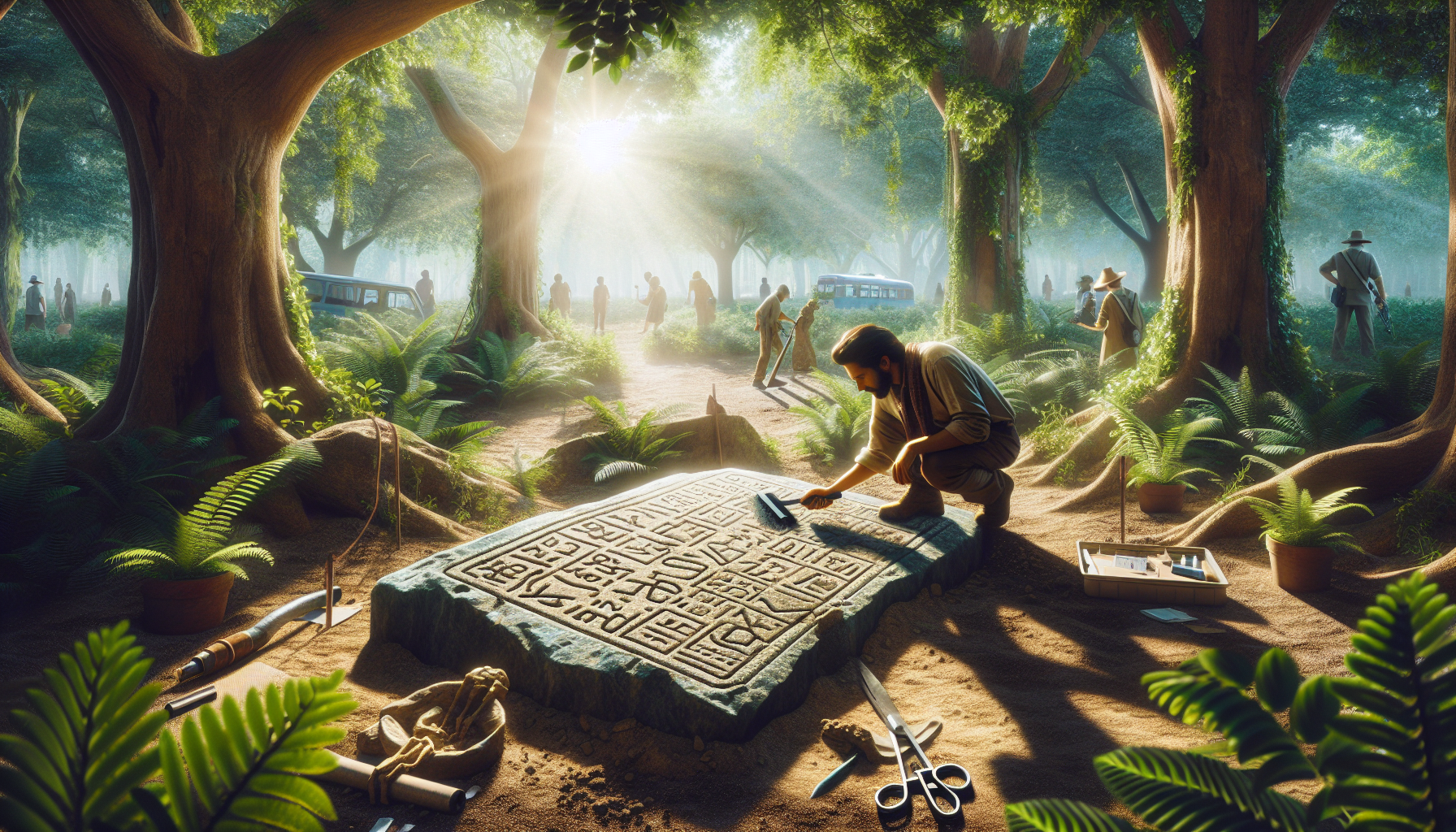In the vast, sun-drenched expanses of the world’s deserts, where the horizon blurs into an endless canvas of golden sands, lies a history steeped in mystery and spirituality. This is a world that seems inhospitable at first glance, yet it cradles secrets of profound importance—a world where ancient whispers of faith and devotion have been carried on the winds for centuries. Welcome to the realm of desert monasticism, a place where solitude and silence form the backdrop for a deep spiritual journey. But within this seemingly barren land, beyond the ancient stone walls of secluded monasteries, lies an even more enigmatic tale: the hidden amulets of the desert monks. These relics, often overlooked, hold the key to understanding the rich tapestry of beliefs and practices that have woven through these isolated communities for millennia. 🏜️
Desert monasticism is a tradition that dates back to the early centuries of Christianity, a time when the desert was seen not just as a physical place, but as a metaphorical landscape for the soul’s journey towards divine communion. The desert, with its stark beauty and harsh conditions, offered a retreat from the distractions of the world, a place where monks could live in simplicity and prayer. These early monks and hermits, seeking purity and spiritual enlightenment, renounced the comforts of society to embrace a life of asceticism. Their days were filled with prayer, contemplation, and manual labor, and their nights with the silent communion with the divine under a canopy of stars. It is within this austere and deeply spiritual context that the tradition of crafting and using amulets emerged.
These amulets, often small and made from humble materials, were not mere trinkets but powerful symbols of faith and protection. They were believed to guard against spiritual and physical dangers, a testament to the monks’ belief in the interconnectedness of the spiritual and material worlds. The crafting of these amulets was a sacred task, imbued with prayer and intention, and their designs often included intricate symbols, religious inscriptions, and natural elements like stones or herbs, each chosen for their symbolic significance and believed power. As such, these amulets offer us a unique window into the spiritual lives of the desert monks, revealing a world where faith was lived and experienced in every moment.
In this blog post, we will journey into the heart of the desert to uncover the secrets of these hidden amulets. We will explore the historical context of desert monasticism, tracing its origins and evolution over the centuries. From the early desert fathers and mothers of Egypt to the monastic traditions of the Middle East and beyond, we will examine how these communities have been shaped by their environments and how they, in turn, have shaped their spiritual practices. We will delve into the symbolism and significance of the amulets themselves, exploring the various materials and designs used and the meanings they held for the monks who crafted and used them. Finally, we will consider the enduring legacy of these amulets and what they can teach us about faith, resilience, and the search for meaning in the modern world.
As we peel back the layers of history and spirituality, we invite you to join us on this fascinating exploration. Whether you are a student of history, a seeker of spiritual wisdom, or simply curious about the hidden stories of our world, this journey promises to be both enlightening and inspiring. Together, we will uncover the secrets of the desert’s hidden amulets, discovering not just relics of the past, but enduring symbols of a timeless quest for divine connection. So, let us set forth into the desert, guided by the wisdom of those who walked its sands before us, and discover the profound mysteries that await in its silence. 🌵✨
The Origins of Desert Monasticism
Desert monasticism, often regarded as one of the most fascinating spiritual movements in history, has its roots deeply entrenched in the arid landscapes of Egypt and the Middle East. This phenomenon, emerging during the early Christian era, saw individuals retreating into the desolate wilderness in pursuit of spiritual enlightenment and deeper connection with the divine. These early monks, known as the Desert Fathers and Mothers, embraced solitude and asceticism, laying the groundwork for monastic traditions that would spread throughout the Christian world. 🏜️
The origins of desert monasticism can be traced back to the 3rd and 4th centuries CE, a time of great upheaval and transformation in the Roman Empire. As Christianity began to spread, many sought to escape the distractions and temptations of urban life, choosing instead the silence of the desert to pursue spiritual purification. The harsh and unforgiving environment of the desert was seen as an ideal setting for this spiritual quest, offering both physical and mental challenges that tested the resolve of those who sought to live a life devoted to God.
One of the most influential figures in this movement was Saint Anthony the Great, often referred to as the Father of All Monks. His life and teachings, chronicled by his biographer Athanasius, inspired countless others to follow in his footsteps. Anthony’s journey into the desert began as a response to the call of Christ to sell all his possessions and live a life of poverty and prayer. His example encouraged many to embrace the monastic lifestyle, leading to the establishment of monastic communities that sought to balance solitude with communal living. These communities became centers of spiritual learning and guidance, attracting followers from near and far.
Key Influences and Practices
The practices of desert monasticism were deeply influenced by the teachings of Jesus and the early Church Fathers, emphasizing simplicity, humility, and detachment from worldly concerns. The monks adopted a rigorous daily routine centered around prayer, fasting, and manual labor, believing that such discipline was essential for achieving spiritual enlightenment. Their lives were marked by silence and meditation, with many practicing hesychasm, a form of contemplative prayer focused on achieving inner peace and union with God.
Another significant aspect of desert monasticism was the practice of living in solitude, often in small cells or caves scattered across the desert. This isolation was not seen as an escape from the world, but rather as a means to confront one’s inner demons and cultivate a deeper relationship with God. The monks believed that the desert offered a unique environment for spiritual growth, free from the distractions and temptations of society.
The legacy of desert monasticism continues to influence modern spiritual practices, with many seeking inspiration from the lives and teachings of the Desert Fathers and Mothers. Their commitment to simplicity, prayer, and self-denial serves as a powerful reminder of the transformative power of faith and the importance of seeking a deeper connection with the divine. To delve deeper into the roots of this spiritual tradition, watch the following video: The Desert Fathers: Ascetics and Monks by Ryan Reeves.
Hidden Amulets and Their Mystical Significance
Among the most intriguing aspects of desert monasticism are the hidden amulets that have been discovered in monastic sites throughout the Middle East. These artifacts, often inscribed with biblical texts, prayers, or symbols, were believed to hold protective and spiritual powers. While their exact purpose remains a subject of scholarly debate, these amulets offer a fascinating glimpse into the spiritual lives of the early monks and their beliefs about the power of sacred objects.
The use of amulets in early Christian monasticism can be traced back to the influence of both pagan and Jewish traditions, which often utilized talismans and charms for protection and healing. For the desert monks, these amulets served as tangible symbols of their faith and a means of invoking divine protection. Many of the amulets discovered feature inscriptions in Greek, Coptic, or Aramaic, with some containing excerpts from the Psalms or other biblical texts. The presence of these sacred words was believed to imbue the objects with divine power, offering protection against evil forces and spiritual maladies.
The mystical significance of these amulets is further underscored by the fact that they were often hidden away, sewn into garments, or buried within monastic cells. This practice suggests that the monks placed great value on these objects, viewing them as essential tools in their spiritual journey. The amulets may have been used in various rituals or as part of personal prayer practices, serving as a constant reminder of the monk’s commitment to a life of faith and devotion.
Comparative Analysis: Amulets and Modern Spiritual Practices
The use of amulets and sacred objects is not unique to desert monasticism, but rather reflects a broader tradition found in many spiritual and religious practices around the world. To better understand the role of these objects, it’s helpful to compare the amulets of the desert monks with those used in other cultures and spiritual traditions.
| Tradition | Purpose of Amulets | Common Symbols |
|---|---|---|
| Desert Monasticism | Protection, spiritual power | Biblical texts, crosses, angels |
| Ancient Egyptian | Protection, health, afterlife | Eye of Horus, scarab, Ankh |
| Jewish Kabbalah | Protection, spiritual insight | Star of David, Chai, Hebrew letters |
| Hinduism | Protection, good luck, spirituality | Om, Swastika, Rudraksha beads |
As shown in the table above, the purpose and symbolism of amulets can vary widely across different traditions, yet they often share common themes of protection and spiritual empowerment. In modern times, the use of sacred objects continues to be an important aspect of many spiritual practices, serving as a means of connecting with the divine and seeking guidance or protection.
For those interested in exploring the spiritual significance of amulets and their role in desert monasticism, consider watching this informative video: Ancient Amulets and Their Mystical Powers by History Explained. This video delves into the history and meaning of these fascinating artifacts, offering valuable insights into the spiritual world of the desert monks.
The Impact and Legacy of Desert Monasticism
Desert monasticism has left a profound legacy on the Christian monastic tradition and continues to inspire spiritual seekers around the world. The principles and practices developed by the Desert Fathers and Mothers laid the foundation for monastic communities throughout the Christian world, influencing both Eastern Orthodox and Western monastic traditions. The emphasis on solitude, prayer, and asceticism remains central to monastic life, serving as a model for those seeking to deepen their spiritual practice.
The impact of desert monasticism extends beyond religious communities, shaping broader cultural and intellectual currents. The monastic centers established by the early monks became important hubs of learning and scholarship, preserving and transmitting ancient texts and knowledge through the centuries. These communities played a crucial role in the development of Christian theology and spirituality, contributing to the rich tapestry of religious thought and practice that continues to evolve today.
In modern times, the teachings and practices of the Desert Fathers and Mothers continue to resonate with those seeking a deeper connection with the divine. Their commitment to simplicity, humility, and devotion serves as a powerful reminder of the transformative power of faith and the importance of seeking a deeper connection with the divine. As more people explore the wisdom of the desert monastics, their legacy continues to inspire and guide those on their own spiritual journeys. To further explore the impact of desert monasticism, consider watching this thought-provoking video: The Legacy of the Desert Fathers by Monastic Wisdom.
- Embrace simplicity and solitude in your own spiritual practice.
- Explore the teachings of the Desert Fathers and Mothers to gain deeper insights into spiritual discipline.
- Consider incorporating sacred objects or rituals into your practice as a means of connecting with the divine.
- Reflect on the transformative power of faith and the importance of seeking a deeper connection with God.

Conclusion
In conclusion, the exploration of “Uncovering the Secrets: Desert Monasticism’s Hidden Amulets” has taken us on a fascinating journey into the mystical and spiritual practices of early Christian monastic communities. Through this article, we delved into the historical context of desert monasticism, uncovering the rich tapestry of beliefs, practices, and artifacts that these ascetic communities have left behind. 🏜️
One of the key points discussed was the historical emergence of desert monasticism, a movement that began in the 3rd century AD as Christians sought to escape the chaos and moral decline of urban centers by retreating into the arid landscapes of the Middle East and North Africa. These monastics were driven by a desire for spiritual purification and communion with God, often living in isolation or small communities. The desert, with its harsh and unforgiving conditions, served as a perfect backdrop for their ascetic practices.
A major focus of this article was the role of amulets within these communities. Amulets, often inscribed with prayers or scriptures, were used not just as protective talismans against evil forces, but also as tools for meditation and connection with the divine. These objects provide a unique insight into the spiritual lives of the desert monastics, revealing their deep-seated beliefs in the power of words and symbols. 🔮
Additionally, we explored the intricate craftsmanship of these amulets, which were often made from materials such as parchment, papyrus, and metals. The artistry involved in their creation underscores the value placed on these items, both as religious artifacts and as personal treasures. The discussion highlighted how these amulets often carried biblical verses, prayers, and symbols, acting as a physical manifestation of faith and protection.
The significance of these amulets extends beyond their immediate practical use. They offer modern scholars and enthusiasts a glimpse into the theological and cultural milieu of early Christianity. By studying these artifacts, we gain a deeper understanding of how early Christians interacted with their faith and how they interpreted and practiced their beliefs in daily life.
Furthermore, the article shed light on the broader impact of desert monasticism on Christian theology and practice. The austere lifestyle and profound spiritual insights of the desert fathers and mothers have left an indelible mark on Christian thought, influencing monastic traditions and spiritual practices throughout the ages. The amulets serve as a testament to the enduring legacy of these early monastic communities and their quest for spiritual enlightenment.
In reinforcing the importance of this topic, it is essential to recognize the relevance of desert monasticism and its artifacts in today’s world. As we navigate an era characterized by rapid technological advancement and increasing secularization, the timeless wisdom and spiritual depth of these early monastics offer valuable lessons. Their commitment to simplicity, reflection, and spiritual discipline can inspire contemporary seekers to explore and deepen their own spiritual journeys. 🌟
To further explore this topic, readers are encouraged to delve into additional resources and research. Websites like the British Museum (https://www.britishmuseum.org) and the Met Museum (https://www.metmuseum.org) offer extensive collections and information on ancient artifacts, including those from early Christian communities. Additionally, scholarly articles available through platforms such as JSTOR (https://www.jstor.org) provide in-depth analyses and discussions on related subjects.
We invite you, our readers, to reflect on the insights gained from this exploration and consider the implications of these ancient practices in your own lives. Share your thoughts and experiences in the comments below, and feel free to engage in a broader discussion on the role of spirituality and historical traditions in contemporary society. By sharing and applying what you have learned, you contribute to a richer understanding of our collective past and its influence on our present and future.
In closing, let us celebrate the enduring legacy of the desert monastics and their hidden amulets. Their journey of faith and devotion continues to resonate, reminding us of the power of spirituality to transcend time and place. As we uncover the secrets of these ancient artifacts, may we be inspired to embark on our own paths of discovery and growth, guided by the timeless wisdom of those who came before us. 🌿
Thank you for joining us on this journey through history, faith, and discovery. We look forward to hearing your thoughts and continuing the conversation.
Toni Santos is a visual storyteller and symbolic artisan whose work unearths the sacred in forgotten places — a seeker of relics not cast in gold, but in petal, vine, and stone.
Through a reverent artistic lens, Toni explores nature as a vessel for unknown religious relics — sacred echoes embedded in botanical forms, remnants of spiritual traditions that were never written but always felt. His creations are not merely decorative; they are quiet devotions, fragments of invisible altars, living prayers suspended in time.
Guided by an intuitive connection to flora and the mysteries they carry, Toni transforms botanical elements into symbolic artifacts — each one a relic of forgotten faiths, imagined rituals, or ancient wisdom left behind by time. His work invites reflection on how the divine speaks through organic beauty, and how the sacred often hides in the overlooked.
As the creative voice behind Vizovex, Toni curates collections and visual meditations that feel like lost sacred texts — poetic, intentional, and charged with quiet meaning. From floral talismans to mythic botanical studies, his work bridges earth and spirit, nature and memory.
His work is a tribute to:
The invisible sanctity found in everyday natural forms.
The mythic energy of plants as spiritual messengers.
The act of creating relics from silence, shadow, and growth.
Whether you’re drawn to mysticism, symbolic art, or the sacredness woven into the natural world, Toni invites you to explore a space where forgotten relics are remembered — one leaf, one symbol, one sacred fragment at a time.





